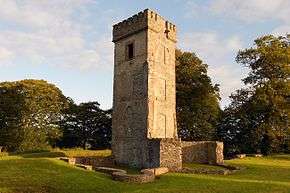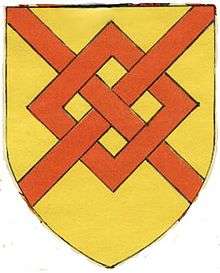Dún Dealgan Motte
| Móta Dhún Dealgan | |||||||||
 Byrne's Folly atop Dún Dealgan Motte | |||||||||
 Shown within Ireland | |||||||||
| Alternate name |
Cú Chulainn's Castle Castletown Motte Castletown Mount Byrne's Folly | ||||||||
|---|---|---|---|---|---|---|---|---|---|
| Location |
Castletown, Dundalk, County Louth, Ireland | ||||||||
| Region | Castletown River Valley | ||||||||
| Coordinates | 54°00′50″N 6°25′49″W / 54.013889°N 6.430278°WCoordinates: 54°00′50″N 6°25′49″W / 54.013889°N 6.430278°W | ||||||||
| Type | motte with castellated house | ||||||||
| Area | 0.85 ha (2.1 acres) | ||||||||
| Diameter | 43 metres (141 ft) (at summit) | ||||||||
| Circumference | 135 metres (443 ft) (at summit) | ||||||||
| Height | 10 metres (33 ft) | ||||||||
| History | |||||||||
| Builder | Bertram III de Verdun | ||||||||
| Material | earth | ||||||||
| Founded | late 12th century | ||||||||
| Periods | Norman Ireland | ||||||||
| Cultures | Cambro-Norman, Old English | ||||||||
| Associated with | Normans | ||||||||
| Site notes | |||||||||
| Public access | yes | ||||||||
| Designation |
| ||||||||
Dún Dealgan Motte is a motte and National Monument located outside Dundalk, Ireland.[1]
Location
Dún Dealgan Motte is located immediately northwest of Dundalk and west of Mount Avenue, on a ridge overlooking the Castletown River.[2]
History and archaeology
Motte

An ancient Gaelic Irish dún once stood here. Some legends claim the site as the birthplace of Cú Chulainn, and it is here that he bases himself in the Táin Bó Cúailgne. The Annals of the Four Masters places a battle here in AD 500.[3]
Early accounts merely call it Dealga, with dún only added after 1002, so it's possible that a fort was only built on the hill around that time. A Z-shaped souterrain, 17 m (56 ft) in length was also dug into the hill in the Gaelic period.
Motte-and-bailey castles were a primitive type of castle built after the Norman invasion, a mound of earth topped by a wooden palisade and tower.[4] Dún Dealgan motte is believed to have been constructed by Bertram III de Verdun (c.1135–1192), with a bailey to the northwest. It was a stronghold of Hugh de Lacy, 1st Earl of Ulster in 1210, but he left it when pursued northwards by King John. On 14 October 1318 it was the site of the Battle of Faughart where the Bruce campaign in Ireland ended with the death of Edward Bruce.[5][6]
Folly
A local man landowner named Patrick Byrne (often called a pirate, due to much of his wealth originating from smuggling) began to build a Gothic house atop the mount. It was damaged in the 1798 Rebellion and only a castellated tower ("Byrne's Folly") remained.
The house was rebuilt in 1850 by Thomas Vesey Dawson as a country retreat, but fell into disrepair and was bought by the County Louth Archaeological and Historical Society to be used for a museum. It was further damaged in the revolutionary period (1919–23)[7]
References
- ↑ Crowl, Philip Axtell (1 January 1990). "The Intelligent Traveller's Guide to Historic Ireland". Contemporary Books – via Google Books.
- ↑ Hagger, Mark S. (1 January 2001). "The Fortunes of a Norman Family: The de Verduns in England, Ireland and Wales, 1066-1316". Four Courts Press – via Google Books.
- ↑ "Dun Dealgan Motte, Castletown, Louth".
- ↑ "Geograph:: Callan Motte (C) dougf". Retrieved 5 September 2016.
- ↑ "Dun Dealgan Motte.".
- ↑ "Dun Dealgan Motte".
- ↑ Past, Ed Hannon-Visions of the (29 March 2015). "Dun Dealgan, Louth, Ireland".